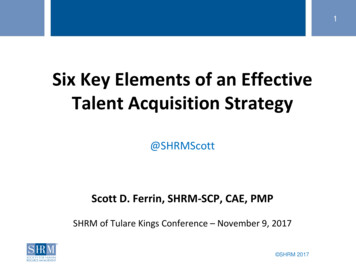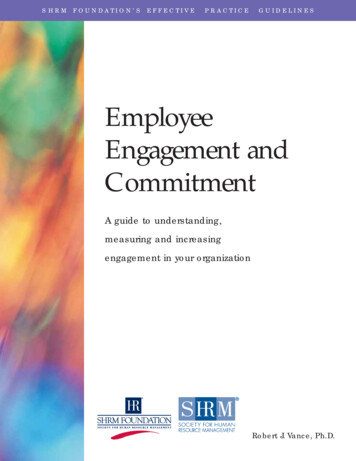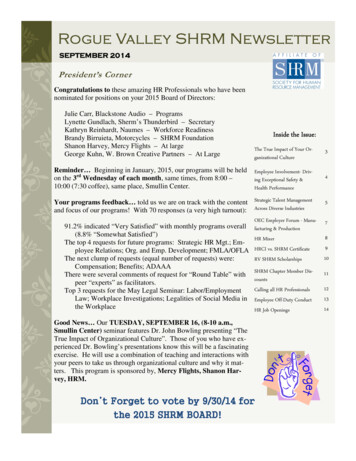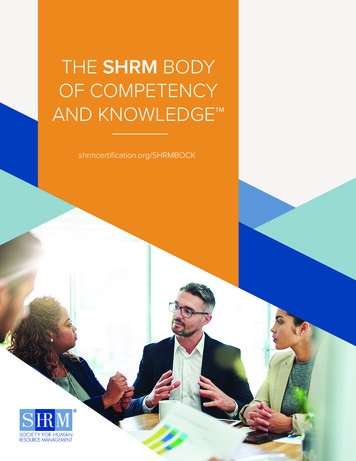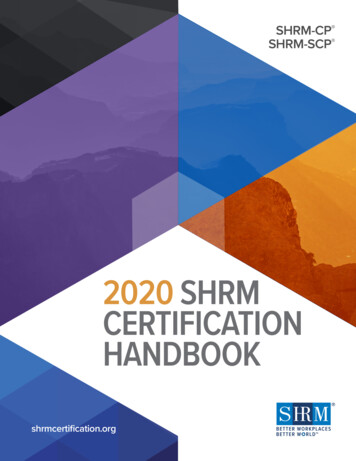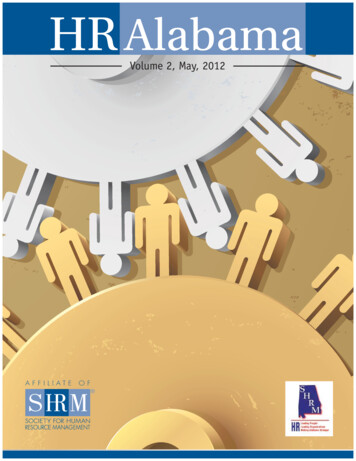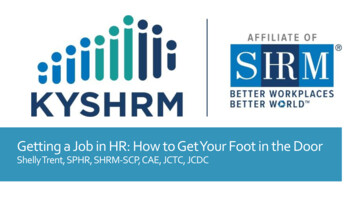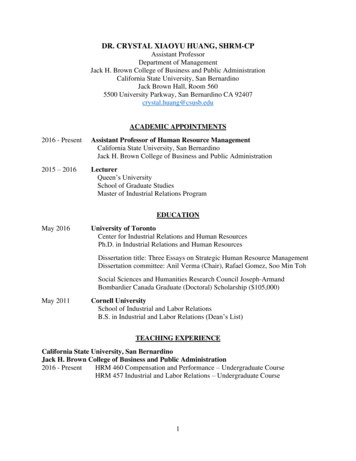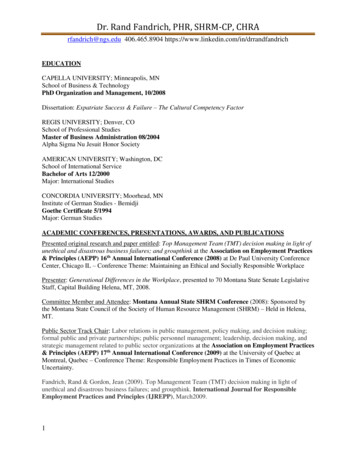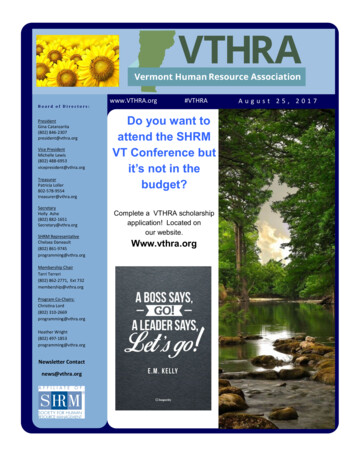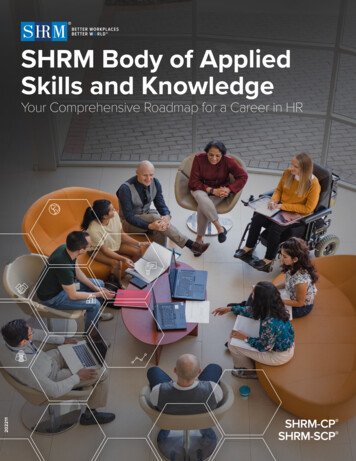
Transcription
SHRM Body of AppliedSkills and Knowledge202211Your Comprehensive Roadmap for a Career in HR
Table of Contents2022 SHRM Body of Applied Skills and Knowledge3SHRM Body of Applied Skills and Knowledge:SHRM BASK Graphic4What Are Competencies?5Knowledge Behavior Success5Development of the SHRM BASK6New Material in the 2022 SHRM BASK8Organization of the SHRM BASK9Leadership ClusterLeadership & Navigation1112Navigating the Organization13Vision14Managing HR Initiatives15Influence16Ethical Practice17Personal Integrity18Professional Integrity19Ethical Agent20Diversity, Equity & Inclusion21Creating a Diverse and Inclusive Culture22Ensuring Equity Effectiveness23Connecting DE&I toOrganizational Performance24Interpersonal ClusterRelationship Management2526Networking27Relationship Building28Teamwork29Negotiation30Conflict Management31Communication32Delivering Messages33Exchanging Organizational Information34Listening35Global Mindset36Operating in a Culturally Diverse Workplace37Operating in a Global Environment38Advocating for a Culturally Diverse andInclusive Workplace39Business ClusterBusiness Acumen4041Business and Competitive Awareness42Business Analysis43Strategic Alignment44Consultation45Evaluating Business Challenges46Designing HR Solutions47Advising on HR Solutions48Change Management49Service Excellence50Analytical Aptitude51Data Advocate52Data Gathering53Data Analysis54Evidence-Based Decision-Making55People Knowledge Domain56HR Strategy57Talent Acquisition59Employee Engagement & Retention61Learning & Development63Total Rewards65Organization Knowledge Domain67Structure of the HR Function68Organizational Effectiveness & Development70Workforce Management71Employee & Labor Relations73Technology Management75Workplace Knowledge Domain77Managing a Global Workforce78Risk Management80Corporate Social Responsibility82U.S. Employment Law & Regulations84Appendix A: Glossary86Appendix B: Resources101SHRM BODY OF APPLIED SKILLS AND KNOWLEDGE2
2022 SHRM BODY OF AP P LIE D S K ILLS AN D K N OW LEDG E2022 SHRM Body of Applied Skills and KnowledgeFor more than 70 years, the Society for Human Resource Management (SHRM) has served the human resources (HR)profession. HR professionals worldwide look to SHRM for comprehensive information and tools to help them effectively performtheir jobs, develop their careers and transform their organizations. Together with SHRM, these HR professionals create betterworkplaces where employers and employees thrive together.In 2011, SHRM began a program of research involving thousands of HR professionals to identify the critical competenciesneeded for success as an HR professional. This research led to the development of the initial SHRM Competency Model,which defined eight key behavioral competencies (Leadership & Navigation; Ethical Practice; Relationship Management;Communication; Global & Cultural Effectiveness; Business Acumen; Consultation; and Critical Evaluation) and one technicalcompetency (HR Expertise). The SHRM Competency Model represented an important advance for the field of HR by focusingon the types of behaviors that are integral for success in HR.The SHRM Body of Applied Skills and Knowledge (SHRM BASK ), formerly the SHRM Body of Competency and Knowledge (SHRM BoCK ), represents the evolution of the SHRM Competency Model by further defining the knowledge areas in additionto the behavioral competencies. The SHRM BASK was developed through a series of large-scale research studies thatincorporated the viewpoints of thousands of HR professionals from around the world. It was most recently updated in 2021, andnow includes nine behavioral competencies as well as one technical competency.In addition to describing the HR field, the SHRM BASK is used to define the content areas of SHRM’s certification examinations:the SHRM Certified Professional (SHRM-CP ) exam for HR professionals in operational roles and the SHRM Senior CertifiedProfessional (SHRM-SCP ) exam for senior-level HR professionals in strategic roles. The two SHRM credentials provide reliableindicators to the global business community that the credential-holder is a recognized expert and leader in the HR field withthe necessary capabilities in both aspects of HR practice—competencies and knowledge—that are required for effective jobperformance.Further, the SHRM BASK is also the common framework for the item writers who develop SHRM-CP andSHRM-SCP exam questions, as well as individuals and organizations developing exam preparation materials. SHRM’s ownoperations for exam development are separate and independent from its operations for study material development. SHRMobserves a strict firewall between these activities to protect the integrity and credibility of the certification exams.SHRM BODY OF APPLIED SKILLS AND KNOWLEDGE3
2022 SHRM BODY OF AP P LIE D S K ILLS AN D K N OW LEDG ESHRM Body of Applied Skills and Knowledge:SHRM BASK LATIONSHIPMANAGEMENTDIVERSITY, EQUITY& ADERSHIP PLEORGANIZATIONWORKPLACESHRM BODY OF APPLIED SKILLS AND KNOWLEDGE4
2022 SHRM BODY OF AP P LIE D S K ILLS AN D K N OW LEDG EWhat Are Competencies?A competency is a group of highly interrelated knowledge, skills, abilities and other characteristics (KSAOs) that give rise to thebehaviors needed to perform a given job effectively. For example, Analytical Aptitude, one of the behavioral competencies inthe SHRM Competency Model, describes a group of KSAOs that include knowledge of research design, critical thinking skillsand deductive reasoning abilities. These KSAOs enable HR professionals to collect, compile, analyze and interpret job-relevantdata and information to support the HR function in their organizations.A competency model is a set of competencies that collectively defines the requirements for effective performance in a specificjob, profession or organization.Competencies can be either technical or behavioral. Technical competencies reflect the knowledge specific to a givenprofession that is required for a professional in that field to perform a particular role. The HR Expertise competency in theSHRM Competency Model describes the technical knowledge specific to the HR field (such as talent management, recruiting, orcompensation and benefits).Behavioral competencies, on the other hand, describe the KSAOs that facilitate knowledge to job-related behaviors. Theyare more general in their applicability than the profession-specific technical competency of HR Expertise. For example, thebehavioral competency Communication describes the KSAOs needed to effectively communicate across a range of media(such as e-mail and oral presentations) and with a variety of audiences (including internal and external stakeholders).In sum, technical competencies reflect what knowledge HR professionals apply on the job, and behavioral competenciesreflect how they apply this knowledge.Knowledge Behavior SuccessSHRM’s incorporation of behavioral and technical competencies into its competency model and certification exams implicitlyrecognizes that a strategic mindset leading to HR success is a function of the successful application of both knowledge andbehavior. In other words, success stems not only from what you know (knowledge) but also what you do (behavior). Neither issufficient in isolation.SHRM’s dual approach to understanding HR success is supported by empirical research that was initially gathered in 20112012 to develop and validate the SHRM BoCK. A study conducted by SHRM in partnership with several leading multinationalemployers and universities found that both HR knowledge and behavior are related to HR professionals’ job performance.Moreover, it found that both knowledge and behavior are uniquely related to job performance in nonredundant ways. Thesefindings support the key contributions of knowledge and behavior to HR success, the relevance and applicability of the SHRMCompetency Model to the HR profession, and the relevance of certification exams that test both behavioral and technicalcompetencies.SHRM BODY OF APPLIED SKILLS AND KNOWLEDGE5
2022 SHRM BODY OF AP P LIE D S K ILLS AN D K N OW LEDG EDevelopment of the SHRM BASKSHRM engaged in a systematic and rigorous program of research to develop the SHRM BoCK. SHRM began this programwith the development of the SHRM Competency Model in 2011, and it continued its effort through 2021 by conducting aseries of activities to further refine the SHRM BoCK as well as validate research in the area of Diversity, Equity & Inclusion.Comprehensive job analysis methods and the active engagement of the global HR community have been used consistentlyto identify, create and refine competencies that describe the attributes necessary for success as an HR professional.SHRM initiated the development of the SHRM Competency Model in 2011 when it conducted 111 focus groups with nearly1,200 HR practitioners, including professionals from 33 countries. Participants in these focus groups represented a diversityof characteristics, both personal (such as career level and tenure) and organizational (such as sector, industry and size).SHRM also conducted a survey of more than 600 chief human resource officers (CHROs) to identify the competencies thatHR leaders believe are required for success in the HR profession. Following this extensive data collection, SHRM createda working competency model of eight behavioral competencies and one technical (knowledge-based) competency, whichtogether describe the personal and professional attributes that HR professionals need for success and career advancement.From 2012 to 2014, SHRM conducted a series of studies with HR professionals to confirm the content of the model and itsrelevance to success in the HR profession.In 2012, SHRM conducted a survey of more than 32,000 HR professionals worldwide to confirm the importance andgeneralizability of the SHRM Competency Model. The results of this study support the relevance of the model in describingthe personal and professional attributes needed for HR success, as well as its wide applicability. SHRM next conducted(also in 2012) a multiorganizational criterion validation study to measure the link between the competency model and jobperformance. The study involved a highly diverse sample of more than 800 HR professionals and their supervisors. Theresults of this study established that proficiency in the SHRM-defined competencies is closely linked to successful jobperformance.In 2014, SHRM conducted a knowledge specification exercise to further develop the HR Expertise technical competency.First, SHRM performed an extensive review of the existing literature on HR knowledge, including textbooks, curricula, syllabiand other educator resources, to determine the universe of potential areas of knowledge that HR professionals need toperform their jobs. SHRM also consulted its own academic and employer surveys regarding the functional knowledge thatHR professionals need to achieve success in the HR field. SHRM drew on this research to create a preliminary knowledgeframework for the SHRM-CP and SHRM-SCP exams.Second, SHRM established in 2014 a SHRM BoCK Advisory Panel of 19 HR and business leaders from various industries,including retail, research, consulting, health care and manufacturing. This panel reviewed the proposed content andframework of the HR Expertise competency to ensure its accuracy and comprehensiveness. The panel also definedassociated key concepts and proficiency indicators for each functional area. Upon completion of these studies, SHRMadopted the framework as the basis for the HR Expertise technical competency.SHRM BODY OF APPLIED SKILLS AND KNOWLEDGE6
2022 SHRM BODY OF AP P LIE D S K ILLS AN D K N OW LEDG EDEVELOPM ENT OF TH E S H RM BAS K - C ON T IN U E DLater, SHRM undertook an extensive refinement of the SHRM BoCK to clarify the competencies and functional areas. This effortwas designed primarily to meet the needs of HR professionals studying for the SHRM-CP and SHRM-SCP exams. Because thecertification exams have been based on the SHRM BoCK, and now are based on the SHRM BASK, the resulting clarificationsalso assist HR subject matter experts who write and refine exam items.SHRM conducted two practice analyses to use as the basis for refining the SHRM BASK. The first practice analysis occurredin 2015-2016, and the second occurred in 2019-2021. The practice analysis process mirrored the process used to initiallydevelop and refine the SHRM Competency Model. During each practice analysis, more than 80 HR professionals, representingthe global HR community with participants from North America, Europe, Africa and Asia, engaged in a series of focus groups.Following the extensive review and revision of each component of the SHRM BASK, SHRM then launched a validation study toconfirm and further refine its contents, collecting responses from more than 8,000 HR professionals around the world.SHRM initially concluded its second practice analysis in March 2020, immediately before the occurrence of a series of majorworld events that had profound effects on workers and the workplace. To reflect those changes, SHRM conducted additionalvalidation research in the area of diversity and inclusion in 2021. SHRM followed the steps in the practice analysis process,including holding focus groups, using a validation survey and revising the SHRM BASK iteratively based on feedback.As a result of this research, SHRM renamed and changed the functional area of Diversity & Inclusion to a behavioralcompetency called Diversity, Equity & Inclusion (DE&I). The revised area of DE&I also includes new content to reflectadditional knowledge, skills, abilities and other characteristics that competent HR professionals need to fully support DE&Iin the workplace. This change also marked a shift in the structure of the SHRM BASK, which now includes nine behavioralcompetencies and one technical competency that is broken into 14 functional areas.SHRM BODY OF APPLIED SKILLS AND KNOWLEDGE7
2022 SHRM BODY OF AP P LIE D S K ILLS AN D K N OW LEDG ENew Material in the 2022 SHRM BASKThe SHRM BASK is the product of extensive review and research that was conducted from 2019 through 2021. The 2022 SHRMBASK more clearly defines and describes the behavioral and technical knowledge required for HR professionals to meet thecurrent and future needs of employers. The revisions provide additional clarity and guidance to facilitate HR professionals’career development and advancement.The most significant design enhancement is the transition from a paper-based booklet to an online, interactive resource. Thisnew format allows HR professionals with an Internet connection to access and use the resource from anywhere, makes theresource easier to navigate, and reduces redundant language.To effectively reflect the current practice of HR, content modifications and enhancements to the 2022 SHRM BASK: Expanded the functional area previously called Diversity & Inclusion and evolved it into a behavioral competency calledDiversity, Equity & Inclusion. Revised the names of two behavioral competencies. Revised the names of two functional areas. Revised and expanded definitions of behavioral competencies and functional areas. Updated, revised and/or expanded sub-competencies, proficiency indicators and key concepts associated with thebehavioral competencies. Updated and expanded proficiency indicators and key concepts associated with the functional areas of the HR Expertisetechnical competency. Added new examples for key concepts throughout the SHRM BASK to help users better understand and interpret thecontent, and reorganized the order of key concepts to flow more logically. Refined and expanded the list of glossary terms and resources.SHRM BODY OF APPLIED SKILLS AND KNOWLEDGE8
2022 SHRM BODY OF AP P LIE D S K ILLS AN D K N OW LEDG EOrganization of the SHRM BASKThe HR competencies and knowledge areas that are assessed on the SHRM-CP and SHRM-SCP examsare detailed in the SHRM BASK.Behavioral CompetenciesThe nine behavioral competencies, which describe the behaviors and attributes necessary for HR professionals to performeffectively in the workplace and operate with a strategic mindset, are grouped into three clusters: Leadership Interpersonal BusinessBehavioral competencies facilitate the application of technical knowledge (i.e., HR Expertise), which may be defined asthe principles, practices and functions of effective HR management. Successful HR professionals must understand thebehavioral components of HR practice in addition to being in command of technical HR knowledge.For each competency, the following information is provided: A Definition of the competency.Key Concepts describing the foundational knowledge for the competency.Sub-competencies applicable to the competency, with definitions.Proficiency Indicators that apply to all HR professionals (i.e., early career through executive career levels) as well as thosethat apply primarily to advanced HR professionals (i.e., senior and executive career levels).SHRM BODY OF APPLIED SKILLS AND KNOWLEDGE9
2022 SHRM BODY OF AP P LIE D S K ILLS AN D K N OW LEDG EO R GANIZATION OF TH E S H RM BAS K - C ON T IN U E DHR Expertise (HR Knowledge)The single technical competency, HR Expertise, is defined as the principles, practices and functions of effective HRmanagement. It is grouped into three knowledge domains—People, Organization and Workplace—and further divided into 14HR functional areas that describe the technical knowledge required to perform key HR activities. Its application is facilitated bythe nine behavioral competencies.For each functional area, the following information is provided: A Definition of the functional area. Key Concepts describing the knowledge specific to the functional area. Proficiency Indicators that apply to all HR professionals (i.e., early career through executive career levels) as well as thosethat apply primarily to advanced HR professionals (i.e., senior and executive career levels).A Note About Proficiency IndicatorsThe proficiency indicators define what competent HR behavior and performance look like in practice. For the two sets ofproficiency indicators listed for each behavioral competency and functional area, it is important to recognize that the indicatorsrelevant to all HR professionals also apply to advanced HR professionals at the senior and executive levels. For instance, whileHR executives may not be specifically proficient in certain functions required of early-career HR professionals, they shouldnonetheless understand the concepts behind those functions, recognize their strategic importance and be able to mentorjunior employees in developing those behaviors. This is particularly important to consider for HR professionals who are studyingfor the SHRM-SCP exam.SHRM BODY OF APPLIED SKILLS AND KNOWLEDGE10
B EH AV IORA L COM PET E N C IE S LE AD E RS H IP C LU ST ERLeadership ClusterThere are three behavioral competencies in the Leadershipcluster: Leadership & Navigation; Ethical Practice; andDiversity, Equity & Inclusion. These competencies describethe behaviors, attributes and underlying knowledge necessaryfor HR professionals to effectively lead and support an HRteam while promoting integrity, accountability, inclusion and theorganization’s core values.Key components of Leadership behavioral competencies include:setting and implementing a vision and direction for the HRfunction; managing or leading organizational initiatives;influencing and supporting other organizational members andleaders; driving an ethical organizational environment; behavingin an ethical manner that promotes high standards of integrity andthe organization’s values; cultivating and supporting a diverseand inclusive culture that supports organizational performance;and ensuring equity effectiveness.SHRM BODY OF APPLIED SKILLS AND KNOWLEDGE11
B EH AV IORA L COM PET E N C IE S LE AD E RS H IP C LU ST ERLeadership & NavigationLeadership & Navigation is defined as the knowledge, skills, abilities and other characteristics (KSAOs)needed to create a compelling vision and mission for HR that aligns with the strategic direction andculture of the organization, accomplish HR and organizational goals, lead and promote organizationalchange, navigate the organization, and manage the implementation and execution of HR initiatives.Sub-competencies: Navigating the OrganizationVisionManaging HR InitiativesInfluenceKey Concepts Leadership theories Examples include situational leadership; transformational leadership; participative leadership; inclusive leadership;leader-member exchange theory; servant leadership; transactional leadership; trait theory; contingency theory People management techniques Examples include directing; coaching; supporting; delegating; mentoring Motivation theories Examples include goal-setting theory; expectancy theory; attribution theory; self-determination theory; equity theory;Herzberg’s 2-factor theory Influence and persuasion techniques Examples include personal appeal; forming coalitions; leading by example; rational persuasion Personal leadership qualities Examples include vision; self-motivation; self-discipline; risk taking; commitment to continuous learning; growth mindsetSHRM BODY OF APPLIED SKILLS AND KNOWLEDGE12
B EH AV IORA L COM PET E N C IE S LE AD E RS H IP C LU ST ER L EA DER S HI P & N AV I GAT I O NSUB-COMPETENCY:Navigating the OrganizationWorks within the parameters of the organization’s hierarchy, processes, systems and policies.PROFICIENCY INDICATORS FOR ALL HR PROFESSIONALS Demonstrates an understanding of formal and informal work roles, leader goals and interests, and relationshipsamong employees and executives. Facilitates communication and decision-making necessary to implement initiatives. Uses awareness and understanding of the organization’s political environment and culture to implement HRinitiatives. Uses an understanding of the organization’s structure, processes, systems and policies to facilitate the successfulimplementation of HR initiatives.FOR ADVANCED HR PROFESSIONALS Uses an understanding of complex relationships among organizational leaders to facilitate the design,implementation and maintenance of initiatives. Uses an understanding of the organization’s political environment to develop and implement HR’s strategicdirection, implement needed changes, and resolve talent needs and issues. Uses an understanding of the complex relationships among the organization’s formal and informal processes,systems and policies to facilitate the development and implementation of HR’s strategic direction.SHRM BODY OF APPLIED SKILLS AND KNOWLEDGE13
B EH AV IORA L COM PET E N C IE S LE AD E RS H IP C LU ST ER L EA DER S HI P & N AV I GAT I O NSUB-COMPETENCY:VisionDefines and supports a coherent vision and long-term goals for HR that support the strategicdirection of the organizationPROFICIENCY INDICATORS FOR ALL HR PROFESSIONALS Embraces and supports the business unit’s and/or organization’s culture, values, mission and goals. Defines actionable goals for the development and implementation of HR programs, practices and policies that support thestrategic vision of HR and the organization. Identifies opportunities to improve HR operations that better align with and support the strategic vision of HR and theorganization. Supports the implementation of HR programs, practices and policies that uphold the strategic vision of HR and theorganization.FOR ADVANCED HR PROFESSIONALS Envisions the current and ideal future states of the HR function, organization and culture to identify gaps and areas forimprovement. Develops the long-term strategic direction, vision and goals of HR and the organization to close the gap between thecurrent and ideal states of the HR function and the organization. Develops and socializes a broad plan to achieve the strategic direction, vision and goals of HR and the organization. Solicits feedback from executive-level stakeholders on strategic direction, vision and goals. Pivots HR strategy, approaches and/or programs in response to significant changes within and outside of the organization.SHRM BODY OF APPLIED SKILLS AND KNOWLEDGE14
B EH AV IORA L COM PET E N C IE S LE AD E RS H IP C LU ST ER L EA DER S HI P & N AV I GAT I O NSUB-COMPETENCY:Managing HR InitiativesImplements and supports HR projects that align with HR and organizational objectives.PROFICIENCY INDICATORS FOR ALL HR PROFESSIONALS Defines and elaborates on project requirements set by leadership.Sets and monitors project goals and progress milestones.Manages project budgets and resources.Identifies and develops solutions for overcoming obstacles to the successful completion of projects.Identifies and monitors the resources necessary to implement and maintain HR projects.Identifies when resource allocation is inconsistent with project needs and makes adjustments as necessary.Demonstrates agility and adaptability when project requirements, goals or constraints change.\FOR ADVANCED HR PROFESSIONALS Translates HR’s vision, strategic direction and long-term goals into specific projects and initiatives with clear timelines andgoals. Monitors the progress of HR initiatives toward achievement of HR’s vision, strategic direction and long-term goals. Collaborates with leadership to remove obstacles to the successful implementation of HR initiatives. Obtains and deploys organizational resources and monitors their effectiveness. Ensures accountability for the implementation of project plans and initiatives.SHRM BODY OF APPLIED SKILLS AND KNOWLEDGE15
B EH AV IORA L COM PET E N C IE S LE AD E RS H IP C LU ST ER L EA DER S HI P & N AV I GAT I O NSUB-COMPETENCY:InfluenceInspires colleagues to understand and pursue the strategic vision and goals of HR and the organization.PROFICIENCY INDICATORS FOR ALL HR PROFESSIONALS Builds credibility as an HR expert within and outside of the organization.Promotes buy-in among organizational stakeholders for HR initiatives.Motivates HR staff and other stakeholders to support HR’s vision and goals.Serves as an advocate for the organization or employees to advance the organization’s strategic direction and goals.Shares opinions about important issues, regardless of risk or discouragement from others.FOR ADVANCED HR PROFESSIONALS Promotes the role of the HR function in achieving the organization’s mission, vision and goals.Builds credibility for the organization regionally, nationally or internationally as an HR expert.Serves as an influential voice for HR strategies, philosophies and initiatives within the organization.Advocates for the implementation of evidence-based HR solutions.Inspires HR staff, non-HR customers and executive-level organizational stakeholders to support and pursue theorganization’s strategic direction, vision and long-term goals. Builds consensus among leaders about the organization’s strategic direction and long-term goals. Uses HR knowledge and skills to influence business strategy. Empowers leaders to create an environment where there is tolerance for risk taking and workers feel comfortable sharingideas.SHRM BODY OF APPLIED SKILLS AND KNOWLEDGE16
B EH AV IORA L COM PET E N C IE S LE AD E RS H IP C LU ST EREthical PracticeEthical Practice is defined as the KSAOs needed to maintain high levels of personal and professionalintegrity, and to act as an ethical agent who promotes core values, integrity and accountabilitythroughout the organization.Sub-competencies: Personal Integrity Professional Integrity Ethical AgentKey Concepts Ethical business principles and practices Examples include transparency; authenticity; conflicts of interest Privacy principles and policies Examples include anonymity; confidentiality; opt-in/opt-out policies Internal ethics controls Examples include protection of employee confidentiality; standards for employee investigationsSHRM BODY OF APPLIED SKILLS AND KNOWLEDGE17
B EH AV IORA L COM PET E N C IE S LE AD E RS H IP C LU ST ER ET HI CA L PR AC T I C ESUB-COMPETENCY:Personal IntegrityDemonstrates high levels of integrity in personal relationships and behaviors.PROFICIENCY INDICATORS FOR ALL HR PROFESSIONALS Shows consistency between stated and enacted values. Acknowledges mistakes and demonstrates accountability for actions. Recognizes explicit and unconscious biases in oneself and others, and takes steps to increaseself-awareness. Serves as a role model of personal integrity and high ethical standards.FOR ADVANCED HR PROFESSIONALS Brings potential conflicts of interest or unethical behaviors to the attention of leaders and executives. Helps others to identify, understand and address their biases. Holds others accountable to their commitments.SHRM BODY OF APPLIED SKILLS AND KNOWLEDGE18
B EH AV IORA L COM PET E N C IE S LE AD E RS H IP C LU ST ER ET HI CA L PR AC T I C ESUB-COMPETENCY:Professional IntegrityDemonstrates high levels of integrity in professional relationships and behaviors.PROFICIENCY INDICATORS FOR ALL HR PROFESSIONALS Maintains privacy as appropriate and complies with laws and regulations mandating a duty to report unethical behavior. Uses discretion appropriately when communicating sensitive information, and informs stakeholders of the limits ofconfidentiality and privacy. Maintains current knowledge of ethics laws, standards, legislation and emerging trends that may affect organizational HRpractice. Leads HR investigations in a thorough, timely and impartial manner. Establishes oneself as credible and trustworthy. Does not take actions based on personal biases. Applies, and challenges when necessary, the organization’s ethics and integrity
2022 shrm body of applied skills and knowledge shrm body of applied skills and knowledge: shrm
